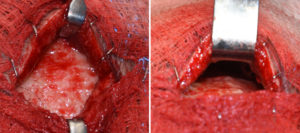Background: The skull is prone to many deviations in its shape of which most are relatively minor. But just because the shape aberration appears relatively small in size compared to the overall skull surface area, this does not mean it is viewed as aesthetically minor to the patient. Ridges, bumps and other ‘high spots’ can be of significant concern to some patients, particularly men who have short or thin hair os even shave their heads.
One of the most common male aesthetic skull deformities is that of the sagittal ridge or sagittal crest. This is a raised midline ridge of bone that develops anywhere along the original sagittal suture between the original anteriornand posterior fontanelles. (soft spots) It is usually thickest at its back end and extends variable distances forward when it gradually gets smaller. It is the result of extra bone growth at the sagittal suture and some have labeled it as ‘microform sagittal craniosynostosis’.
Sagittal ridge skull reduction is done with a burring technique to remove the thickened bone. While this concept is ‘simple’, it must be done in an aesthetic manner that limits the scalp scar and prevents any damage to the hair follicles.


Sagittal Ridge Skull Reduction Dr Barry Eppley IndianapolisSagittal ridge skull reduction is an effective and safe procedure. But it must be done from an aesthetic perspective with a resultant small scalp incision and preservation of all hair follicles if present.
Case Highlights:
1) A sagittal ridge in men is one of the most common aesthetic skull deformities. (I have never seen one in a woman)
2) Sagittal ridge skull reduction is done through a small scalp incision along a narrow subperiosteal tunnel.
3) Reducing the sagittal ridge 5 or 6mms is usually sufficient to reduce its prominence.
Dr. Barry Eppley
Indianapolis, Indiana



